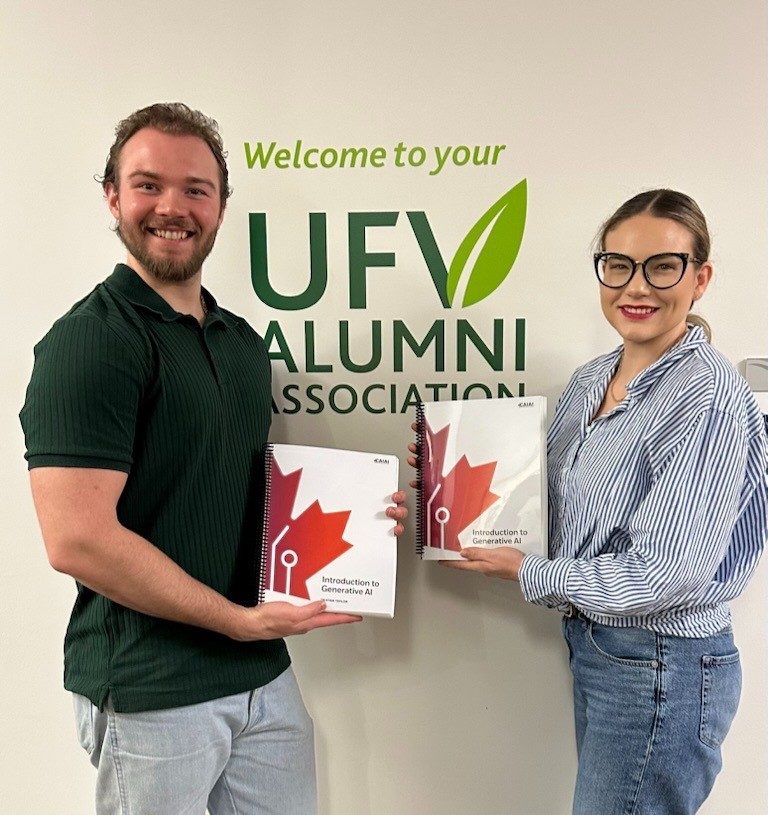Tristan Taylor: charting new frontiers in AI learning

It wasn’t just a serious head injury that changed the course of Tristan Taylor’s life; the advent of machine learning models, popularly known as generative Artificial Intelligence (AI), also played a big role. As the founder of the Canadian Artificial Intelligence Advancement Institute (CAIAI), Tristan is always seeking to educate institutions on the use of AI.
Following a car accident just three weeks out of high school, recovery for Tristan was a long road; the concussion he suffered in the crash left him feeling confused, his thoughts often muddled. As a result of his injury, when he entered university, he did not study Kinesiology as he had planned. Rather, he took a more creative route and found a passion for English.
During his years at UFV, where he earned a Liberal Arts diploma in 2023, he found his instructors extremely supportive throughout his recovery, with some even going as far as to dim classroom lights to accommodate his light sensitivity.
During this time, he took a geology course that first introduced him to working with AI.
“The way that I study is to make a set of flashcards, and then I make a set of quizzes, and then I make a set of exams,” says Tristan. “It consumed a ridiculous amount of time.”
He was aware of AI tools at the time and decided to experiment with them to make studying easier. He would upload his classroom notes and have AI develop practice exams.
“It got to the point where for midterms and finals, I actually created draft exams for the class and handed them out,” says Tristan.
His instructor was frequently impressed with the quality of his practice exams. Tristan would give her copies of each one, to ensure transparency in what he was doing.
And on the final practice exam, Tristan was surprised to discover that his AI-generated exam came out nearly the same as the one being given to the students for the course.

Launching an institute
After graduating, Tristan went on to develop his skills in AI. He worked with fellow UFV alum Keenan Beavis (BBA ’18) at Longhouse Branding & Marketing, using AI to increase their business potential.
“Over the course of my time there, I educated pretty much everyone on the team how to apply those tools in their day-to-day work and life,” says Tristan.
But it was one of the other employees at Longhouse who encouraged Tristan to investigate educating people outside of their organization.
That challenge led him to establish CAIAI.
“Calling it an institute is very intentional,” explains Tristan. “My goal is to partner with Canadian universities to deliver AI content that is suited to students and business owners and organizations.”
To ensure that CAIAI delivers the best product possible, Tristan upgraded his own knowledge, completing several micro-credentials in AI, which, in turn, alerted him to a need within the industry.
Tristan set out to write his own textbook to create a foundation of knowledge around AI and its use, currently in progress. He’s consulted with experts, including one of the key engineers of Open AI, the company that owns Chat-GPT.
He’s walking the talk by integrating AI tools into his own creative endeavours, setting an example for aspiring AI enthusiasts. He takes a meticulous approach to ensuring that the tools he recommends in his textbook are long-lasting and high-quality.
“I’m constantly testing different tools in my spare time,” says Tristan. “Always trying out something new. Seeing how the prompting differs from each one and making an informed recommendation.”
The future of AI
Tristan sees two possible futures for AI in North America — one that is industry led, where companies push what is possible — or one that is institutionally led, where understanding and education pave the way.
“The advancements are way farther ahead than most of the scientists working with the tools actually even understand,” says Tristan, outlining a concern he frequently comes across when working in AI.
“Everyone is always going to look to their institution to be the guiding voice,” he continues. “And in my head, who better to guide the future of AI adoption than the institutions themselves? That’s the future that I see for AI. And I want to be a part of that.”
For this reason, Tristan has been working tirelessly to develop his foundational textbook. And now that it is nearing completion, he has begun developing digestible courses that can be presented to institutions, and courses developed for students, each taught by CAIAI experts.
By providing a baseline of education around AI tools, he hopes to alleviate some of the fear and potential for misuse.
“To get AI in the hands of everyone, we have to have a foundation of knowledge,” says Tristan.
You can learn more about the Canadian Artificial Intelligence Advancement Institute by visiting their website https://www.caiai.ca/
